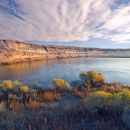A national monument is established by executive order of the president or by Congressional legislation. The Antiquities Act authorizes the president to proclaim “historic landmarks, historic and prehistoric structures, and other objects of historic or scientific interest” as national monuments. Concerns about protecting mostly prehistoric Indian ruins and artifacts— collectively termed “antiquities”—on western federal lands prompted the legislation. Its purpose is to allow the president to preserve public land quickly without waiting for Congressional legislation. The ultimate goal is to protect all historic and prehistoric sites on federal lands. The National Wildlife Refuge System helps manage two national monuments:
- Hanford Reach National Monument, co-managed in Washington state with the Department of Energy
- World War II Valor in the Pacific National Monument, co-managed in Hawaii, Alaska and California with the National Park Service

